House Of The Dragon Season 2 Episode 5’s Gross Game Of Thrones Callback Explained
Contains spoilers for “House of the Dragon” Season 2 Episode 5
At the end of the fourth episode of Season 2 of “House of the Dragon,” titled “The Red Dragon and the Gold,” the red dragon in question falls. During the Battle of Rook’s Rest, where the inept boy king Aegon II Targaryen (Tom Glynn-Carney) faces his aunt and enemy force Rhaenys Targaryen (Eve Best) with both of them on dragonback, neither fighter knows that Aegon’s brother Aemond (Ewan Mitchell) is waiting in the nearby woods … with his legendarily large dragon Vhagar. Aemond and Vhagar attack both Aegon and Rhaenys mid-air, also injuring their respective dragons Sunfyre and Meleys, with the former and its rider falling out of the sky entirely. Ultimately, Vhagar grabs Meleys by the neck and beheads her after an agonizingly long attack, leading to Rhaenys’ death in the episode’s final, gut-wrenching moments.
Watching Rhaenys and Meleys die is difficult enough. Watching Meleys’ severed head paraded through King’s Landing in the following episode is just insult to injury. As Aegon’s soldiers show off the head of the “traitor” dragon and falsely credit their king, it feels all too familiar … because in “Game of Thrones,” the King in the North, Robb Stark (Richard Madden), experienced something similar. Specifically, after his murder at the Red Wedding alongside his mother, wife, and unborn child, enemy soldiers also kill Robb’s faithful direwolf Grey Wind, decapitate the wolf, and stitch it to Robb’s head in a cruel act of pageantry.
Dragons and direwolves are both closely bonded to their humans in Westeros — making these scenes much more gutting
After killing your enemy, it’s pretty reprehensible to then take the head of their faithful animal companion and put it on display like it’s a parade float (not that this is necessarily a common dilemma, but in Westeros it sure is). Direwolves and dragons, though, are intrinsically linked to their human counterparts in this universe, which makes this move that much more insidious.
Let’s look back at Robb Stark and Grey Wind, who first meet in the pilot when Robb’s father Ned (Sean Bean) and his children discover a litter of direwolf puppies in the woods near Winterfell. The litter’s mother is dead after an altercation with a stag, and despite initially objecting, Ned agrees to let each of his children take one direwolf and raise them when his “bastard” child Jon Snow (Kit Harington) points out that the pups represent the sigil of House Stark. The direwolves don’t fare particularly well during “Game of Thrones,” but as we see with Jon and his wolf Ghost, they’re almost psychically linked; Robb’s younger brother Bran (Isaac Hempstead-Wright) can even “warg” into his wolf and exist within the animal’s mind.
Targaryens, similarly, are bonded to the dragons they ride, and Rhaenys rode Meleys for decades before “House of the Dragon’s” narrative even begins. The two are essentially one being while they’re in the air, and the look in Rhaenys’ eye as she watches her dragon die before her is absolutely crushing. Showing off the heads of Grey Wind and Meleys after the fact is especially vile when you consider that these creatures represent a real part of their fallen companions.
Team Green might have made a major misstep by displaying Meleys’ head in King’s Landing
When you really think about the fact that Team Green — led by Aegon, Aemond, and their mother Alicent Hightower (Olivia Cooke) — decided to brag about their victory by using the head of a severed dragon as a trophy, it does betray one thing about that particular faction: they may not have thought about the real implications of such a presentation. When audiences first see dragons in “Game of Thrones,” they’re incredibly rare — the only character who can wield their power is the “mother of dragons” herself, Daenerys Targaryen (Emilia Clarke) — but in “House of the Dragon,” they’re commonplace … at least amongst the members of the powerful and royal Targaryen family. “True” Targaryens are expected to be dragonriders and, as has been established, form close bonds with their dragons, ideally soon after the dragon hatches from its egg. Still, they’re basically Westeros’ version of a nuclear weapon, and anyone who’s not a Targaryen with a custom-made dragon saddle understandably fears them.
Sure, Team Green wants to make Team Black (which Rhaenys represented in the Battle at Rook’s Rest for Queen Rhaenyra Targaryen, played by Emma D’Arcy) look weak by showing off Meleys’ head, but they also raise questions about their own dragons. As one King’s Landing citizen remarks upon seeing the dragon’s head, dragons aren’t “gods” and can be slain like anything else … which means that Team Green’s dragons are just as vulnerable as Meleys was. The battle between Team Green and Team Black will surely rage on, but now, outsiders know that either side can watch a dragon fall, proving that neither King Aegon nor Queen Rhaenyra is truly infallible … and exposing a potential weakness to their subjects.




